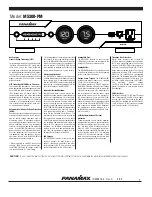
CTs connected to the protected zone. These IEDs are designed in such a way that the
current distribution through the IED differential branch during all transient conditions
caused by non-linearity of the CTs will not cause the unwanted operation of the
differential IED. In order to obtain the required secondary CT current distribution, the
resistive burden in the individual CT secondary circuits must be kept below the pre-
calculated value in order to guaranty the stability of the IED.
In new numerical protection IEDs, all CT and VT inputs are galvanically separated
from each other. All analog input quantities are sampled with a constant sampling rate
and these discreet values are then transferred to corresponding numerical values (that
is, AD conversion). After these conversions, only the numbers are used in the
protection algorithms. Therefore, for the modern numerical differential IEDs the
secondary CT circuit resistance might not be a decisive factor any more.
The important factor for the numerical differential IED is the time available to the IED
to make the measurements before the CT saturation, which will enable the IED to take
the necessary corrective actions. This practically means that the IED has to be able to
make the measurement and the decision during the short period of time, within each
power system cycle, when the CTs are not saturated. From the practical experience,
obtained from heavy current testing, this time, even under extremely heavy CT
saturation, is for practical CTs around two milliseconds. Because of this, it was decided
to take this time as the design criterion in REB 670 IED, for the minimum acceptable
time before saturation of a practical magnetic core CT. Thus, the CT requirements for
REB 670 IED are kept to an absolute minimum. Refer to section
secondary e.m.f. requirements"
for more details.
However, if the necessary preventive action has to be taken for every single CT input
connected to the differential IED, the IED algorithm would be quite complex. Thus, it
was decided to re-use the ABB excellent experience from the analog percentage
restrained differential protection IED (that is, RADSS and REB 103), and use only the
following three quantities as the inputs into the differential algorithm in the numerical
IED design:
1. incoming current (that is, sum of all currents which are entering the protection
zone)
2. outgoing current (that is, sum of all currents which are leaving the protection zone)
3. differential current (that is, sum of all currents connected to the protection zone)
These three quantities can be easily calculated numerically from the raw sample values
(that is, twenty times within each power system cycle in the IED) from all analog CT
inputs connected to the differential zone. At the same time, they have extremely
valuable physical meaning, which clearly describes the condition of the protected zone
during all operating conditions.
Section 6
1MRK 505 370-UUS A
Differential protection
112
Busbar protection REB670 2.2 ANSI
Application manual
Summary of Contents for RELION REB670
Page 1: ...RELION 670 SERIES Busbar protection REB670 Version 2 2 ANSI Application manual ...
Page 2: ......
Page 24: ...18 ...
Page 40: ...34 ...
Page 72: ...66 ...
Page 102: ...96 ...
Page 266: ...260 ...
Page 272: ...266 ...
Page 290: ...284 ...
Page 432: ...426 ...
Page 542: ...536 ...
Page 552: ...546 ...
Page 553: ...547 ...
















































